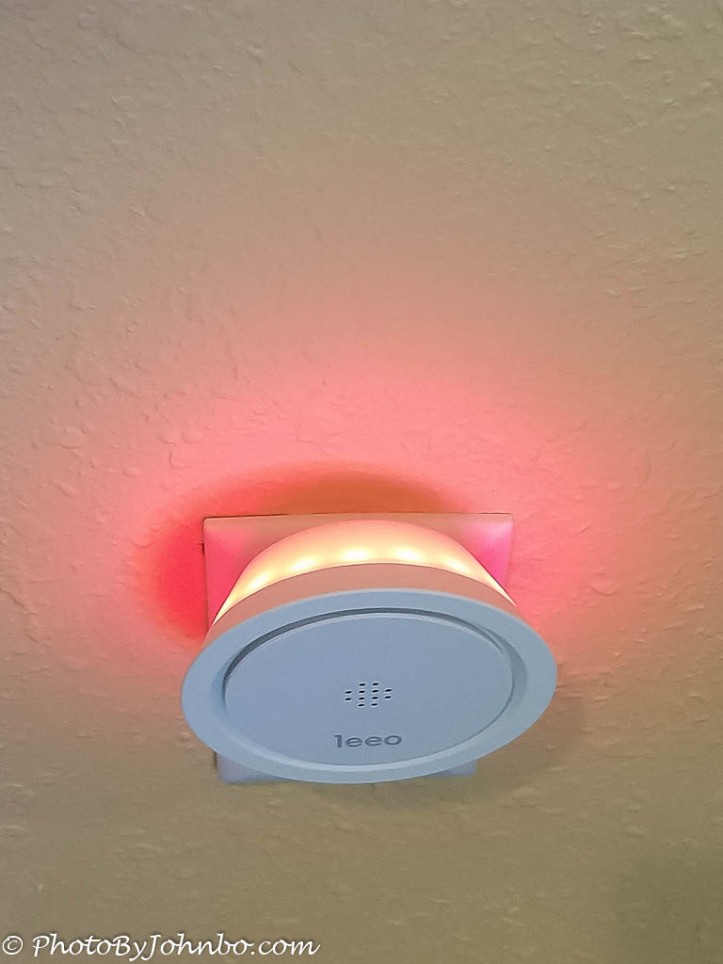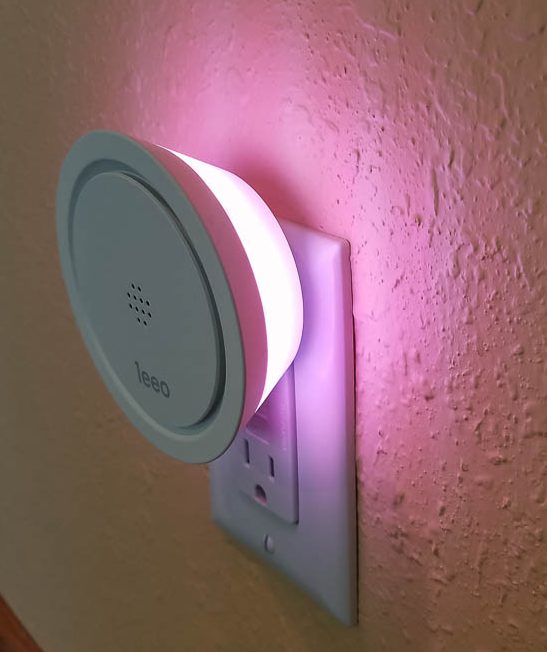Yes, this looks like a strange and extra large night light. The holes might give you the impression it’s a bluetooth speaker, but those holes are the devices “ears”, not its “mouth.” But I digress… what is an article about this device doing in my travel and photo blog? Because I travel a lot, and spend almost half a year away from our home in Fargo, I am always looking for devices that keep an eye (or an ear) on our home while we are away.
This digression is a review of a product that’s been monitoring my Fargo Condo for several months. If I’d have had this device in February of 2013, it might have saved us a 10-month stay in an apartment while our building was being cleaned and two units completely rebuilt because of a fire. You see, Leeo listens for the standardized sound of a fire alarm. Those holes hide a sensor that is capable of discerning the difference between the sound of a smoke alarm, a CO (carbon monoxide) alarm and even a water alarm. When it hears an alarm, it uses WiFi to start calling people from a pre-populated calling list. Once a call is answered, it plays back the sound of the alarm to allow you to confirm the alarm sound is not a false alarm. It is then up to you to notify appropriate authorities. As a bonus, it’s a smart phone programmable night light, and it reports the current temperature and humidity in the residence when you check in to the app on your Android or IOS device. In the photo above, the device is on in nightlight mode. You can tell it to burn the light continuously or only illuminate when the room is dark. When we leave for days or months at a time, we leave the night light off. No reason to have it on.
 The photo above is a screenshot of the night light brightness and color display. You can select a color from the palette and adjust its brightness from one screen. The display above was captured by my iPad. Control is easy and intuitive, you just have to lift your finger from the display for the new setting to take effect, and you can make the adjustment from wherever you’re connected to the Internet.
The photo above is a screenshot of the night light brightness and color display. You can select a color from the palette and adjust its brightness from one screen. The display above was captured by my iPad. Control is easy and intuitive, you just have to lift your finger from the display for the new setting to take effect, and you can make the adjustment from wherever you’re connected to the Internet.
 The main screen provides temperature and humidity. The temperature agrees completely with my other household thermometers, though I’ve found the humidity function to be largely inaccurate. It always reads high. Though it would be nice if the humidity reading was correct, knowing the temperature in the room is good enough for me and maybe a future software update will fix the humidity readings. Upgrades to the device itself are automatic and happen via the device’s WiFi connection to your network.
The main screen provides temperature and humidity. The temperature agrees completely with my other household thermometers, though I’ve found the humidity function to be largely inaccurate. It always reads high. Though it would be nice if the humidity reading was correct, knowing the temperature in the room is good enough for me and maybe a future software update will fix the humidity readings. Upgrades to the device itself are automatic and happen via the device’s WiFi connection to your network.
 What I bought the device for, however, is fire alarm control. Pressing the test button on a smoke alarm brings Leeo to life and it starts calling people on the notification list. The fire that started in our building began in the ceiling above our unit. Though I don’t know for sure, I suspect the fire smoldered in the ceiling area for days before starting to get enough oxygen to break into flame. My condo wasn’t damaged by flame but by smoke and water damage. I can only guess that the alarms in my unit sounded for quite a while before one of our neighbors awoke and smelled smoke. We were in Arizona at the time and our upstairs neighbor was also away. This device might have given us enough warning to mitigate our damage.
What I bought the device for, however, is fire alarm control. Pressing the test button on a smoke alarm brings Leeo to life and it starts calling people on the notification list. The fire that started in our building began in the ceiling above our unit. Though I don’t know for sure, I suspect the fire smoldered in the ceiling area for days before starting to get enough oxygen to break into flame. My condo wasn’t damaged by flame but by smoke and water damage. I can only guess that the alarms in my unit sounded for quite a while before one of our neighbors awoke and smelled smoke. We were in Arizona at the time and our upstairs neighbor was also away. This device might have given us enough warning to mitigate our damage.
The image above demonstrates the visual appearance of the unit during an alarm. The yellow wall in our condo makes the light look less red in the photo than it actually displays during an alarm condition. After experimenting with one of these units in our condo, I purchased a second unit, set it up and tested it. That unit will travel with us to Arizona and be installed in our home there. Both residences have wired alarm systems so that when one sounds, they all sound. Leeo only has to be placed in a room where one of the devices is located. If your alarms aren’t interconnected, you will need to purchase multiple Leeo units that can be located within hearing of each individual alarm. Don’t rush out and buy one for every alarm you have, though, until you find out which alarms it cannot hear. You can plug Leeo into any electrical outlet within range of the sound of your alarm system.
I hope I never again need to have the use of one of these devices, but the $50 USD price tag is a small price to pay for peace of mind. Happy travels!
John

What a cool device! It’s amazing what is coming out now in the “smart phone” category of home comfort/security!